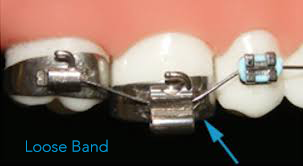Maintenance: Keep Smiling!
You’re on your way to a healthier bite and smile! Now that you have your braces, you may have a few questions.
Brushing & Flossing
*During orthodontic treatment, brush your teeth really well, twice daily, to avoid the accumulation of food particles in your teeth and braces.
*Concentrate on the danger zones- the space between the bands or brackets and the gums!
*Floss at night to make sure your teeth are clean before you go to bed. When you first begin flossing around your braces, your gums may bleed a little. If the bleeding does not go away after the first few times, inform a staff member at your next appointment.
Foods to Avoid
Eating proper foods, minimizing sugar intake and getting enough sleep are essential during orthodontic treatment. Hard foods, sticky foods and foods high in sugar must be avoided. Hard foods can break or damage wires and brackets. Sticky foods can get caught between brackets and wires. Use common sense when choosing food to put in your mouth and avoid chewing on hard objects such as pens and pencils.
*Whole fruits and vegetables such as apples and carrots should be cooked or cut into small pieces and eaten carefully to avoid injury to your braces.
Aligner Care Instructions
*Watch this helpful one minute video about your aligners
Common Problems
You may experience soreness caused by the brackets rubbing against your lips or cheeks. Rinse with a warm salt water solution (one teaspoon of table salt in a six ounce glass of warm water) and apply soft wax to the area to relieve discomfort. Your teeth may be sensitive for one to three days after placement of your appliances and for one or two days after most adjustments. This tenderness is the normal reaction of teeth to new pressure and can be relieved with Ibuprofen. If your teeth are extremely tender after an appointment, let us know so that we may determine the best level of pressure for you.
If you are not careful with the foods you choose to eat, you can damage your braces and other orthodontic appliances. If you have a loose bracket and it is still attached to the wire, you should leave it in place and put wax on it and/or call our office for advice if a bracket or wire is loosened.
Smoothing Rough Edges of Clear Aligners, Invisalign and Clear Retainers
Sometimes there can be rough edges on clear aligners, Invisalign and clear retainers. These sharp edges can be easily smoothed at home with an emery board or nail file and water.
The first step is to find the rough spot on the aligner with your finger. Once the spot has been identified you can smooth the rough spot or edge with your emery board moving in one direction, not back and forth. Once the aligner or retainer feels smooth rinse under running water.
- Clear aligners, Invisalign and clear retainers should be kept out of direct sunlight.
- Brush aligners and retainers with toothpaste and toothbrush twice a day.
- Clear aligners, Invisalign and clear retainers should be removed when eating or drinking.
- Efferdent tablets can be used to soak aligners and retainers to prevent build-up.
- Keep clear aligners and retainers away from animals, or they will become your pets new chew toy.
There is a proper way to remove clear aligners, Invisalign and clear retainers from your mouth that will prevent the aligner or retainer from cracking or breaking. To remove aligners, on one side of your mouth, use your fingertip on the inside of your back molar to slowly pull the aligner from your molars. Repeat this process on the other side of your mouth before trying to completely remove the aligner.

In case of emergency
Call our office as soon as possible if you break or loosen any of your appliances.
When a true orthodontic emergency happens, as unusual as they are, we are available for you. Please call in case of emergencies such as severe pain or a painful appliance or braces problem you cannot correct yourself, and we will schedule an appointment for you.
Some orthodontic problems can be solved at home until we can schedule an appointment to see you. If your braces or appliance have a loose piece that you can remove, such as a bracket or band, put it in a safe place and bring it with you to your next visit. If you are experiencing slight pain or discomfort often it is due to a wire poking or sticking out. Often this discomfort can be alleviated by placing wax on the sharp appliance or by sliding the wire back in place with pliers, replacing it back in the tube that it has come out of.
Once the discomfort is eased it is still important to call our office to schedule an appointment so that we can make the necessary repairs. Allowing appliances or braces to remain broken for long periods of time may have a negative impact on your treatment plan.
An orthodontic emergency is a situation where you are in pain or discomfort due to a damaged appliance, a wire that has shifted and is poking your cheek or gum, or a blow to your face or teeth. If this occurs, please call our office at 231-347-4049 as soon as possible.
Use this diagram to tell us what is loose or broken.
In the unlikely case of discomfort that you cannot manage, we are available when you need us.




If the bracket or band is still attached to the wire, leave it in place. If it is uncomfortable, cover the bracket with wax. If it comes out completely, bring it with you to the next appointment. Call for an appointment. DO NOT CONNECT HEADGEAR OR ELASTICS TO A LOOSE BAND.
Please call to ask if an appointment is necessary for a lost elastic tie.

If a wire comes out of the tube, try to place the wire back in the tube with tweezers. The wire can also be clipped with a nail clipper. Place wax if uncomfortable and call for an appointment. This also applies to a poking archwire.


GENERAL SORENESS FROM BRACES
Rinse the mouth with warm salt water. If necessary, take the pain reliever that you would use for a headache or similar discomfort. You can also place wax over anything that may be rubbing inside the mouth.
HEADGEAR
Headgear discomfort can sometimes be caused by improper wear. Be sure to refer to the instructions that Dr. Fry and staff provided. The headgear should hurt less the more it is worn, so be sure you wear it the number of prescribed hours.
If the facebow (metal piece) is bent, please call our office for assistance.
APPLIANCE DOES NOT FIT
Please call for an appointment.
Glossary
- archwire
- A wire engaged in orthodontic attachments, affixed to the crowns of two or more teeth and capable of causing or guiding tooth movement.
- band (orthodontic)
- A thin metal ring, usually stainless steel, which serves to secure orthodontic attachments to a tooth. The band, with orthodontic attachments welded or soldered to it, is closely adapted to fit the contours of the tooth and then cemented into place.
- bracket
- An orthodontic attachment that is secured to a tooth (either by bonding or banding) for the purpose of engaging an archwire. Brackets can be fabricated from metal, ceramic or plastic.
- ceramic brackets
- Crystalline, alumina, tooth-shade or clear synthetic sapphire brackets that are aesthetically more attractive than conventional metal attachments.
- crowding
- Dental malalignment caused by inadequate space for the teeth.
- crossbite
- The upper teeth sit inside the lower teeth, which may cause tooth stratification and misaligned jaw growth.
- debanding
- The removal of cemented orthodontic bands, bracket and glue.
- dental midlines not matched up
- This type of problem is caused when the back bite does not fit and match appropriately, which negatively impact jaw and proper dental function.
- elastics (rubber bands)
- Used to move teeth in prescribed directions (commonly connected to molar band and upper ball hook). Found in numerous colors for better appearance.
- gingiva
- The tissue that surrounds the teeth, consisting of a fibrous tissue that is continuous with the periodontal ligament and mucosal covering.
- headgear
- Generic term for extraoral traction (attached around the back side of the head) for growth modification, tooth movement and anchorage.
- imaging
- The process of acquiring representations of structures in either two or three dimensions.
- lingual
- Of or pertaining to the tongue. A term used to describe surfaces and directions toward the tongue.
- lingual appliances
- Orthodontic appliances fixed to the lingual surface of the teeth.
- maxillary
- Of or pertaining to the upper jaw. May be used to describe teeth, dental restorations, orthodontic appliances or facial structures.
- openbite
- Proper chewing is impacted by this type of bite, in which the upper and lower front teeth do not overlap. Openbite may cause a number of unwanted habits, such as tongue thrusting.
- orthodontist
- A dental specialist who has completed an advanced post-doctoral course, accredited by the American Dental Association, of at least two academic years in the special area of orthodontics.
- orthognathic surgery
- Surgery to alter relationships of teeth and/or supporting bones, usually accomplished in conjunction with orthodontic therapy.
- overbite
- Vertical overlapping of upper teeth over lower teeth, usually measured perpendicular to the occlusal plane.
- radiograph
- A permanent image, performed digitally in our office, produced by ionizing radiation. Sometimes called an X-ray after the most common source of image-producing radiation.
- retainer
- Any orthodontic appliance, fixed or removable, used to maintain the position of the teeth following corrective treatment.
- retention
- The passive treatment period following active orthodontic correction during which retaining appliances may be used.
- spacing
- Spacing problems may be caused by missing teeth, or they may only be a cosmetic or aesthetic issue.
- straight wire appliance
- A variation of the edgewise appliance in which brackets are angulated to minimize multiple archwire bends. Brackets and molar tubes have specific orientation in three planes of space.
- upper front teeth protrusion
- The appearance and function of your teeth are impacted by this type of bite. It is characterized by the upper teeth extending too far forward or the lower teeth not extending far enough forward.
FAQ
Frequently Asked Questions
-
What does “Integrative Orthodontics” even mean?
Integrative Orthodontics means we understand that crooked teeth are not the problem. They are the symptom of an imbalance somewhere in the face, head, neck or body. We treat the causes of the imbalance as much as possible. We will work as a team with your other healthcare professionals.
-
At what age should I schedule an appointment for an orthodontic screening?
The American Association of Orthodontists recommends an orthodontic screening at age 7. By this age, several permanent teeth in most children have erupted, allowing us to effectively evaluate your orthodontic condition and determine if braces or other appliances such as an expander is needed to correct a growth concern. By seeing an orthodontist at age 7, a baseline can be established for eruption and growth of the face. Early intervention while growing can have positive effects and prevent need for corrective jaw surgery when older if left untreated. When a baseline is established, eruption concerns such as impacted teeth can be found or prevented by regular orthodontic check-ups (observation appointments).
-
How do I schedule an appointment for an initial orthodontic evaluation?
If you or your child can potentially benefit from orthodontic treatment, simply call our office. We will be happy to schedule an appointment for you. No referral is necessary for orthodontics/braces. If no current orthodontic needs are found, a recommendation for observations will be scheduled to monitor growth and development (our younger patients).
-
What will happen/what will you learn from the initial orthodontic evaluation?
We will take the necessary photographs and X-rays to allow us to make a proper diagnosis. The doctor will then complete a thorough evaluation.
There are five essential questions that we will cover during the initial orthodontic evaluation:1. Is there an orthodontic problem, and if so, what is it?
2. What must be done to correct the problem?
3. Will any teeth need to be removed?
4. How long will the treatment take to complete?
5. How much will the treatment cost? When should treatment begin?
-
Will I need to have teeth extracted for braces?
Removing teeth is sometimes required to achieve the best orthodontic result. Straight teeth and a balanced facial profile are the goal of orthodontics. However, removing teeth is not always necessary for orthodontic treatment because new technology has provided advanced orthodontic procedures.
-
How long will it take to complete treatment?
Treatment time obviously depends on each patient’s specific orthodontic problem. In general, treatment time lasts from 8 months to 30 months. The average time frame a person is in braces is approximately 18-24 months.
-
How much will braces/aligners cost? Are financing options available? How does my insurance work?
At most orthodontic examinations, full records are taken to completely examine your case during your appointment. Almost always will an exact fee be determined at your initial appointment. If you or your child has a more complicated case, Dr. Fry may give a fee range and request a treatment conference to discuss options further. Generally you can expect to receive a cost for your braces/aligners at your exam appointment.
If your insurance plan covers orthodontic treatment, you will receive the benefit of reduced personal costs. We will submit claims in your behalf and work with you to help you receive your orthodontic benefit. Insurance policies vary and we will review yours to determine the appropriate course of action.
-
How often will I have appointments?
Appointments are scheduled according to each patient’s needs. Most patients in braces will be seen every 6 to 10 weeks. If there are specific situations that require more frequent monitoring, we will schedule appointments accordingly.
-
Do braces hurt?
Generally, braces do not hurt. After certain visits, teeth may be sore for a few days. In these situations, pain medications such as Advil or Tylenol will ease the mild discomfort.
-
What is Phase One (early) Treatment?
Phase One Treatment, if necessary, is usually initiated on children between the ages of 7 and 10. Phase 1 orthodontic treatment usually lasts about 6 -18 months. The primary objective for Phase 1 orthodontic treatment is to address significant problems to prevent them from becoming more severe, prevent impacted teeth by monitoring and assisting eruption patterns. Phase 1 treatments include: braces, expanders, facemasks, biteplanes, headgear, aligners, tongue fences, habit correctors, frankel appliances, occlusal guards, and more. Each person has their own needs and each treatment plan is tailored for optimal correction of the growth discrepancy found.
-
Is it too late to have braces if I am already an adult?
A surprising percentage of our patients are adults. In fact, 25 percent of all orthodontic patients are adults. Health, happiness and self-esteem are vitally important to adults. No patient is “too old” to wear braces!








